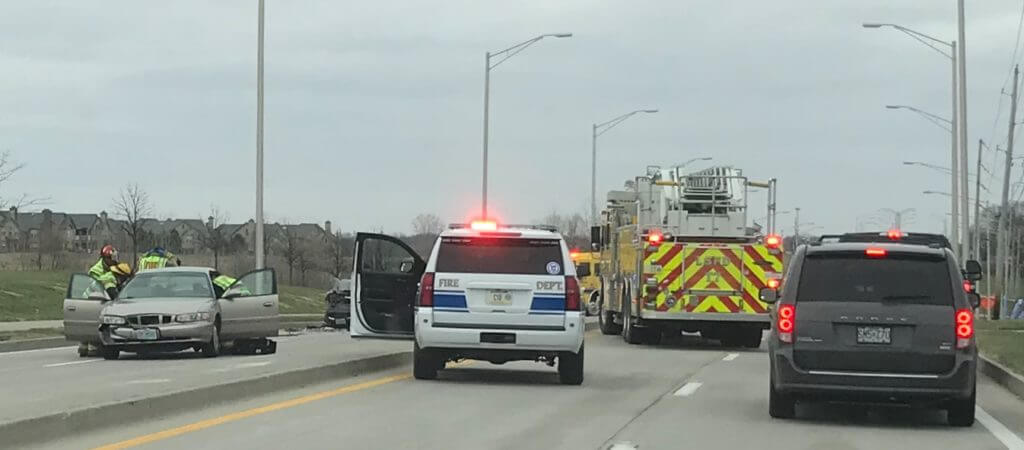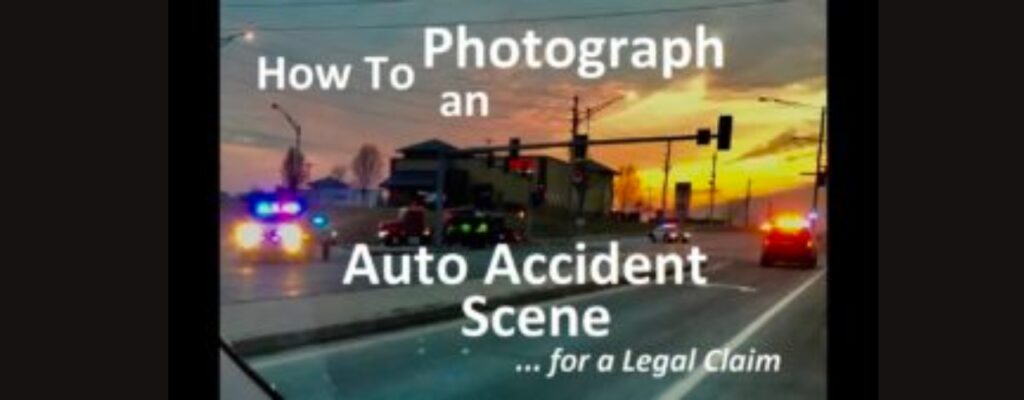THE TYPES OF CASES THAT REQUIRE PROPER ACCIDENT SCENE PHOTOGRAPHS
Applicable for the following types of cases:
• Personal injury cases
• Wrongful death cases
• Insurance Claims
TYPES OF ACCIDENT SCENES
Accident Scene photographs are applicable to any event where someone is injured or killed because of the negligence of another person or entity. However, these are most often experience in the following types of events:
• Auto accidents
• Bicycle Accidents
• Motorcycle Accidents
• Truck crashes
• Slips and Falls
• Construction injuries
• Train Wrecks
• Defective Roads
WHY PROPER ACCIDENT SCENE PHOTOS ARE CRITICAL
Why is taking accident scene photographs important? They will:
• Increase case value
• Increase the credibility of your claims
• Simplify proving your case
WHO NEEDS TO TAKE PROPER ACCIDENT SCENE PHOTOS?
The people who need this information are those making, or defending, the claim. This is typically:
• The victim
• The victim’s attorney
• An investigator
• Someone helping the victim
• The wrongdoer
• Someone helping the wrongdoer
WHY IS A SCENE PHOTO DIFFERENT? WITNESS PRESENTATION.
Accident Scene photographs are different. Accident photographs should be looked at as exhibits to use at a trial. These photographs will be used during witness testimony. As much as possible, back up what the witness says every step of the way with a demonstrative photograph. It will make sure you get all the testimony covered. It will keep your witness presentation on track and in order. Presenting photographs with witness testimony will bolster the credibility of the witness. It will also make the testimony more memorable. Remember, the jury can’t take the witness back in the jury room to deliberate. However, if you admit the photographs, those can go back with the jury. Insurance companies and corporate defendants know this. Thus, good accident scene photographs bolter your case.
ACCIDENT SCENE INVESTIGATION

Good, proper, Accident Scene photographs help the investigative process as well. They allow you to analyze the scene when you are remove in location and time from the event. Good, comprehensive accident scene photography helps formulate and perfect case strategy.
THE IMPORTANT REASON YOU FORGOT ABOUT
One might say; why do I need all these photographs, from all these angles? Why put so much effort if most won’t get used? Those unused photographs are your “ace in the hole.” They can reveal liars and prove those lies to a jury. You would be amazed how otherwise good, honest, well meaning, people can develop “creative memory” when their self-interests get involved.
They will be helping you and admitting fault at the time of the accident, think about it over a period of time, and oppose you when your claim is made. It often is not intentional; the wrongdoer convinces themselves they are innocent and the victim is at fault. Here is where your good accident scene photography comes in. Take the photographs, and help these witnesses come around to the truth they have chosen to forget.
So; what to do? Go through the following steps
TAKE IMMEDIATE ACTION IF THE ACCIDENT SCENE GOING TO CHANGE?

Did the injury or death happen at a location that changes? For example,
• Was it a construction site?
• Did the accident occur in traffic?
• Were there car parts?
• Are there skid marks?
• Was there a weather issue?
Get out to the scene and take photographs immediately if this is true. The sooner the better.
I advise getting out to the scene as soon as possible in any event. You are going to have to invest the time and effort anyway. Better to reduce your risk and get your claim started “on the right foot.”
HOW SIMILAR IS THE SCENE NOW COMPARED TO THE ACCIDENT?
Accuracy is paramount when taking accident scene photographs. Yes, as discussed above it is important to photograph the accident scene as soon as possible. However, next, consider the conditions.
• What is the sun like?
• How is the weather? Blue sky versus clouds
• Snow?
• Rain?
• Leaves on trees?
• A particular traffic event?
• A particular construction event?
It is not unusual for me to calendar photographing an accident scene exactly one year from the date and time of the accident. This can be a good approximation.
Remember, the insurance company or other lawyer will want to look at your accident photo, and criticize any little detail as difference, saying that it is inaccurate. If the judge agrees, this may keep it out of evidence entirely.
CHOOSE THE RIGHT CAMERA LENS

Use your cellular phone camera if that is all you have available. However, if you have access to a professional DLSR camera; use it. You’ll take better photographs and have fewer problems. This blog and our YouTube channel has a stand-alone article and video at https://www.law-kc.com/lawyer-accident-scene-camera-lens-use-choice/ discussing these very topics. It is important to master this step.
Choose the right lens. You may want a 35mm lens, or a telescopic zoom lens, or a 50mm lens. Macro lenses are critical for defective product cases; any time a very small object needs to be photographed in detail.
360 DEGREES – THE FIRST THING TO DO WHEN ARRIVING AT ACCIDENT SCENE
The first thing to do when arriving at an accident scene is get out your camera, put it in video mode, and start the video. Make a full 360 degree turn all the way around. Do it slowly, so if you need to stop frame later on, you can see what is being filmed. This will ensure you have access to this information if it later becomes important for your accident claim and was not on your mind while you were at the accident scene.
INCLUDE THE WEATHER IN YOUR PHOTOS
You’ll be surprised how often little details, like the weather, become important in cases. Your witnesses may discuss it. The wrongdoer, or insurance company may claim it is a factor. Better to preserve the weather.
If you’re unsure of the weather at the time of the accident, look to online weather forecasting websites. Many have archives of weather, temperature, cloud cover, and wind at the time and location of the accident. Remember, you want the jury looking at your accident photographs, and going through the events in their own mind, as if they are actually standing there during the accident.
CAR ACCIDENTS – SKID MARKS AND SHAKE DOWN

It is important to photograph the road itself in any auto accident case. “Shake down” is referred to as the broken parts of the car that fly off during a car crash. Skid Marks, are tire marks left on the road from vehicles, stopping, skidding, or rolling. If there are things on the road after a car accident; photograph them. If there are NO skid marks; if there is no shake down on the road after a car accident; photograph that too. This will preserve the scene for later use.
USE A TAPE MEASURE

Take a measurement device to the accident scene. Take your accident scene photographs with a measurement from a known spot, and without the tape measure. Think in advance about any important measurements that should be taken. Don’t just “wing it” once you’re there. Make a list in advance. Go through your list once you are there. That way it is thought through and complete.
Also, once at the accident scene; look for any unforeseen issues that can be covered. Measure those as well. Later accident reconstruction will find this invaluable.
TAKE FAR AWAY ACCIDENT SCENE PHOTOS

You will want to document through photographs all the accident scene. This will require you walking far away from the accident scene and getting photographs of the scene as a whole. Also, get up high. Try to take photographs from above.
PHOTO AND VIDEO MOVEMENT AT THE ACCIDENT SCENE
• Auto Accident scenes have traffic and moving cars.
• Car crashes at intersections have the behavior of vehicles as the lights turn.
• Train wrecks show what can be seen as a train approaches.
• Bicycle accidents show how far away the bicycle can be seen by a motorist.
This is where the video mode on your camera comes in. Switch to video and document movement at the scene.
• How much time did the victim have to react?
• How much of a distraction was the construction?
• How long did it take for the vehicles to get there.
• What did the approaching harm look like to the victim? How much time in advance did the wrongdoer have?
• What would they have seen?
Take video both from the perspective of the victim and the wrongdoer. These items of video can be used to bolster the credibility of your witnesses or to impeach the lies told by others. So, take video from both points of view. All of these items are important pieces of evidence to gather.
MAKE A LIST. IN ADVANCE!
You don’t want to forget a photo you thought of in advance and forgot at the scene, when you became distracted.
WHAT HAS YOUR EXPERIENCE BEEN?
Please comment and let us know what you believe are the most important accident scene photographs. Please look to www.law-kc.com for additional information on accidents and how to get justice from the losses they impose.



